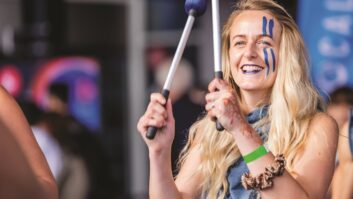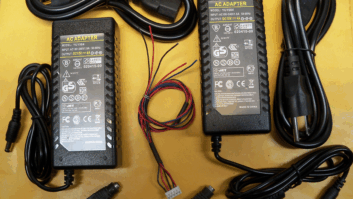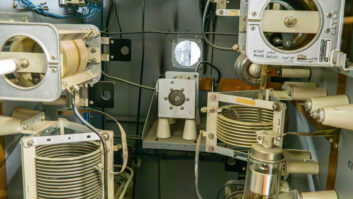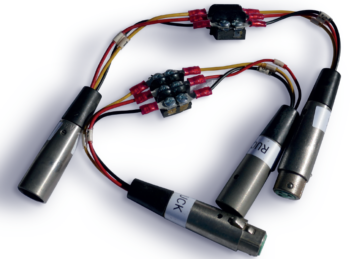
San Francisco Projects Engineer Bill Ruck and I have been conversing via email about the Pin 1 grounding issue discussed in Workbench in December and January, especially the problem encountered when interfacing gear to an outside source, such as an event sound contractor.
Bill built up a variety of XLR adaptors that he keeps organized in one of those black cotton bags found at Harbor Freight. The first photo shows his male and female XLRs brought out to a barrier strip.
This adaptor makes lifting grounds or switching “HOT” pins on the XLR easier than disassembling and resoldering connector pins. Now Bill can try different configurations with only a screwdriver and see what works best. He can also change from balanced to unbalanced by moving the lugs on the barrier strip.
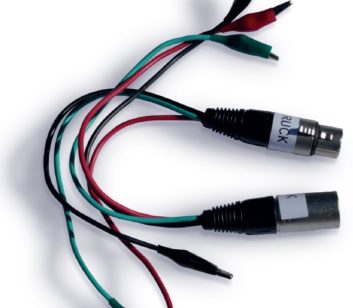
The rig in the second photo can be used in a similar fashion, as it brings the terminals out to alligator clips. Bill made up two other adaptors, seen in the third image. On the left, this jumper has Pins 2 and 3 reversed. The assembly on the right lifts the ground, Pin 1.
You’ll note that Bill took advantage of his labeling machine to identify all the adaptors and to include his name — less of a chance of something “walking off.”
Bill also provided a link to an interesting series of papers about the “Pin 1 problem” should you want further information. The URL, appropriately enough, is www.pin1problem.com.
Gotta run for shade
Alan Peterson, national production director and weekend program coordinator for the Radio America Network in Arlington, Va., and former Radio World columnist, has been following our Pin 1 discussion too. He offered a simple mnemonic to remember the order of XLR connections: “2 is Hot, 3 is Not.”

Likewise, Alan reminded me that Kool & The Gang permanently cemented the standard in 1979 when they rolled out the song, “Too (2) Hot.” Hum that to yourself and you will never forget!
He adds that he wished XLR plug manufacturers would emboss larger numbers on those connectors. Yes, Alan, my eyesight is failing, too.
Alan then surprised me with news that he’ll be retiring in March from Radio America. Congratulations!
Man Cave
I’ve gotten a number of great comments about our description of Harry Simons’ living room studio, which he built in retirement. More than one engineer wanted to know what Harry’s wife had to say about turning the living room into a studio. No problem there, Harry’s single!
Slippery when cold
When it snows and sleets down in the Carolinas and Georgia like it did recently, you know it’s winter. And that means keeping something handy to keep your locks working.
We’ve written about the many great applications of WD-40 Multi-Use Product. Educational Media Foundation Field Tech Scott Todd writes that when it comes to spray lubricants, especially for locks, you may also want to try a couple of other options, both available from Amazon.
The reviews for PB B’laster Penetrant note that it stinks. Also, that it’s a great penetrating oil but not a silicon lubricant. PB B’laster Silicon Lubricant, on the other hand, contains a higher concentration of silicone than other brands, which means longer-lasting lubrication. It’s formulated with a Teflon polymer. This compound is a clear, non-evaporating formula that can lubricate and protect not only metal, but also plastic, wood, rubber, vinyl and leather products.
[Check Out More of Workbench Here]
Scott says that in his opinion, the gold standard in lock lubricants, bar none, is Kano Laboratories’ Penephite Graphited Penetrating Oil. On Amazon, this spray has a 78% five-star review. It consists of a combination of oils, solvents and micron-sized graphite in a suspension. The oils and solvents carry the graphite into infinitely small spaces to loosen frozen parts. Once deposited, the graphite provides long-lasting lubrication.
Strong not silent
Back in September 2019, we published a Workbench tip from EMF’s Ken Beckwith about constructing an EAS Loop antenna out of PVC. Carroll Broadcasting’s Lance Coon wrote in recently to say he was looking to build this antenna for his stations but needed clarification on one point.
In the article, we mentioned improving the “strength” of the loop by adding a piece of conduit down its middle.
Lance wanted to confirm that be “strength,” we meant the rigidity of the loop, not the strength of the signal.
Lance, you are right. To increase the signal strength or sensitivity, you’d add more turns of wire to the loop. Mounting shouldn’t be critical; just be sure the edge of the loop is pointing toward the EAS signal you want to receive. Be sure to send us a picture of your completed project, Lance!
John Bisset, CPBE, has 50 years in broadcasting and is in his 32nd year writing Workbench. He handles western U.S. radio sales for the Telos Alliance and is a past recipient of the SBE’s Educator of the Year Award.
Workbench submissions are encouraged and qualify for SBE recertification credit. Email [email protected].




